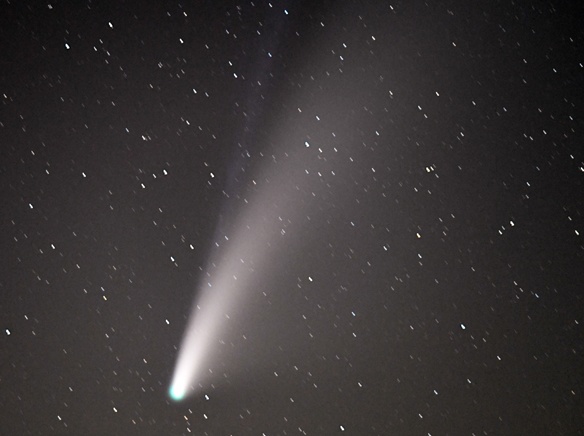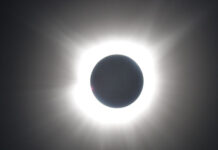It’s an opportunity that presents itself, in this case, once every 6,953 years.
That’s the length of time it takes Comet NEOWISE to make one circuit around the sun.
Currently, the comet is dazzling sky-watchers in the early evening skies after an equally impressive showing in the morning skies at the beginning of the month.
The comet is expected to be visible to the unaided through the end of the month; it is easy to pick out at a dark sky site due to its glowing tail.
NEOWISE, named after the Near-Earth Object Wide-field Infrared Survey Explorer on its discovery on March 27, is currently skimming through the paws of the constellation Ursa Major, the Great Bear, in the northwestern part of the sky. It becomes visible about an hour after sunset and is visible for up to two hours.
Look for the bowl of the Big Dipper; the comet is located about midway from the bottom of the dipper bowl to the horizon.
No visual aid is necessary but binoculars or a telescope can make the viewing experience more rewarding.
The comet will look like a fuzzy star, but the tail is the dead giveaway.
It is possible to photograph the comet with the use of a tripod and a digital SLR camera. Exposures can be made from 640 to 2,000 ISO between two and 10 seconds depending on the focal length of the lens used and the desired effect.
As the comet recedes from the sun, it is expected to diminish in brightness. At present, it is moving through a marvelous sprinkling of stars, which adds a bit of stardust majesty to photographs.
Comets have been best characterized as dirty snowballs, ices mixed with silicate material, left over from the formation of the solar system. They are among the most pristine objects in space.
The nucleus of NEOWISE is estimated to be three miles in diameter.
Since naked-eye comets are generally rare — Hale-Bopp gained acclaim in 1997 — enthusiasts often gather in sizable numbers to view them. The advent of social media has definitely helped peak interest among the general public.
Among any particular observing group, a few come prepared with telescopes, many more with binoculars, some with cameras and some just with armchairs and a blanket.
So far, NEOWISE has exceeded expectations in terms of brightness.
Though the comet can be spotted from the city if one knows exactly where to look, the comet is best seen from the back country, including the mountains and desert, where there is less interference due to urban sky glow.
A good observing site would be on northwest-facing turnouts along Sunrise Highway on Mount Laguna.
The comet is climbing higher in the sky each night after passing through perihelion (closest approach to the sun) on July 3 and is currently outbound from the inner solar system on its near-parabolic 6,953-year orbit.
Photographers will note two tails actually streaming from the comet’s head – a thin ion (gas) tail and a much larger dust tail.
The ion tail always points away from the sun due to radiation pressure while the larger dust tail follows the comet’s orbital path and has noticeably curved into a fan tail as it has left the sun’s immediate vicinity.
The comet’s head, or coma, has a distinctive green hue under magnification. The green color is due to due interaction with ultraviolet light from the sun on molecules bound in cometary ices.
The gas tail has a blue color while the dust tail has a yellowish color.
The comet is currently about 56 million miles from the sun and 64 million miles from the earth. Its orbit will take it 67,704 million miles from the sun at aphelion, its farthest distance from our parent star.
Get out and enjoy it while you can!













